Online Articles
The Ichthus
(slightly adapted)
 I know you have seen it on T-shirts, sweatshirts, bracelets, necklaces, lapel pins, bumper stickers, and castings on trunk lids. I am referring to the little fish symbol which sometimes has the five letters on it. To many people, it has become as much a symbol of the Christian faith as the cross itself.
I know you have seen it on T-shirts, sweatshirts, bracelets, necklaces, lapel pins, bumper stickers, and castings on trunk lids. I am referring to the little fish symbol which sometimes has the five letters on it. To many people, it has become as much a symbol of the Christian faith as the cross itself.
What does it mean? What are those funny letters? What difference does it make?
The symbol is called an ichthus (pronounced "ickthoose"), which is a Greek word for "fish," and is spelled by those five Greek letters that often appear on that symbol. Ichthus, in the original language, is spelled lota Chi Theta Upsilon Sigma. Those five letters stand for five words that confess our Lord: "Jesus Christ, God's Son, Savior." An acrostic is an arrangement of words in which the first letter of each line ordinarily combines with others to form a word or words or the alphabet. Ichthus stands for Iesous (Jesus) CHristos (Christ) THeou (of God) Uiou (the Son) Soter (the Savior).
The fish symbol has been used for millennia worldwide as a religious symbol associated with the pagan "great mother goddess." The fish symbol was often drawn by overlapping two very thin crescent moons. One represented the crescent shortly before the new moon; the other shortly after, when the moon is just visible. The moon is the heavenly body that has long been associated with the goddess. The link between the "mother goddess" and fish was found in various areas of the ancient world:
In China, the great mother Kwan-yin is often portrayed in the shape of a fish.
In India, the goddess Kali was called the "fish-eyed one."
In Egypt, Isis was called the "Great Fish of the Abyss."
In Greece the Greek word "delphos" meant both fish and womb. The word is derived from the location of the ancient Oracle at Delphi who worshipped the original fish goddess, Themis. The later fish goddess, Aphrodite Salacia, was worshipped by her followers on her sacred day, Friday. From her name comes the English word salacious" which means lustful or obscene.
Throughout the Mediterranean, mystery religions used fish; wine; and bread for their sacramental meal.
In Scandinavia, the Ugreat goddess" was named Freya and fish were eaten in her honor.
Thus, the ichthus was already well established both in the East and the West by the latter half of the second century. Please remember that this symbol is never mentioned in the Bible, nor does the Bible ever sanction Christians to use symbols to identify themselves. Nevertheless, by the second century, the symbol was appearing on sarcophagi, rings, seals, and catacombs used by Christians, and the earliest direct evidence for the symbol with its accompanying letters is from slightly before the year A.D. 180 in the eighth Sibylline Oracle.
Somewhere around the year A.D. 200, an influential writer named Quintus Tertullian wrote a short treatise on baptism for the benefit of those in his local church who were studying in preparation to be baptized. In this treatise, he made the remarkable observation that "we as little fishes, in accordance with our ichthus Jesus Christ, are born in water" (On Baptism 1). So, this "invented" symbol was a confession of Christ of sorts, but it was also indelibly connected with water baptism. In fact, the baptistery itself used to be called a piscina (fish pond) by the Latin writers in those early days and Christians were referred to as pisciculi. The symbol was furthermore used among Christians as a type of password during times of persecution. If two strangers met and were unsure whether each other was a Christian, each one would draw an opposite arc, thus forming the outline of a fish.
I find it very ironic that most of the people, being members of a denomination, who decorate themselves with the fish symbol on their T-shirts, sweatshirts, bracelets, necklaces, lapel pins, and bumper stickers or castings on their trunk lids do not believe that baptism in water is necessary for the remission of sins. Yet they proudly display the very symbol that early Christians connected with the necessity of baptism in being born again (John 3:3-5;-Mark 16:16; Acts 2:38; 22:16; 1 Peter 3:21). So the next time you see someone sporting that symbol, ask him if he knows what it means. From there you can perhaps have an opportunity to teach him the gospel of Christ.
Teaching people about Christ takes a lot of courage, and it pays to have knowledge. That symbol is everywhere. Use it as a tool to reach lost souls, and it will help you get a conversation started with many people whom you would otherwise not know how to approach.




